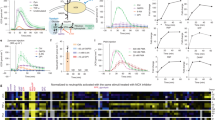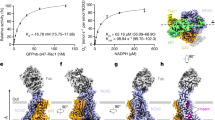Abstract
THE phagocytic process in guinea pig polymorphonuclear leucocytes (PMN) is accompanied by increases in the rates of oxygen consumption, of glucose oxidation by the hexosemonophosphate shunt and of formate oxidation to carbon dioxide1–3. The availability of triphosphopyridine nucleotido (NADP) appears to regulate the rate of glucose oxidation by the shunt in leucocytes3,4. Attempts have been made to correlate the stimulated activity of the hexosemonophosphate shunt in phagocytizing leucocytes with increased NADPH oxidation. The evidence indicates that NADPH oxidation in phagocytizing leucocytes is not accomplished by the classical route of hydrogen transport by way of cytochrome reductase and cytochrome c (ref. 1) nor by means of an NADP-linked lactate dehydrogenase2. Iyer, Islam and Quastal2,3 obtained results showing that PMN possess an enzyme system capable of oxidizing NADPH and NADH by a reaction involving the formation of hydrogen peroxide. The enzyme, however, is much more active towards NADPH than towards NADH and its activity is strongly enhanced by manganese ions3. Rechcigl and Evans5 have suggested that a hydrogen-peroxide-destroying system, such as myeloperoxidase, which is found in high concentrations in leucocytes6 may be important in protecting the cell from toxic effects of hydrogen peroxide. Results described here show that the oxidation of reduced triphosphopyridine nucleotide in PMN may be accomplished by a reaction involving peroxidase.
This is a preview of subscription content, access via your institution
Access options
Subscribe to this journal
Receive 51 print issues and online access
$199.00 per year
only $3.90 per issue
Buy this article
- Purchase on Springer Link
- Instant access to full article PDF
Prices may be subject to local taxes which are calculated during checkout
Similar content being viewed by others
References
Sbarra, A. J., and Karnovsky, M. L., J. Biol. Chem., 234, 1355 (1959).
Iyer, G. Y. N., Islam, M. F., and Quastel, J. H., Nature, 192, 535 (1961).
Iyer, G. Y. N., and Quastel, J. H., Canad. J. Biochem. and Physiol., 41, 427 (1963).
Beck, W. S., J. Biol. Chem., 232, 271 (1958).
Rechcigl, M., and Evans, W. H., Nature, 199, 1001 (1963).
Schultz, J., and Kaminker, K., Arch. Biochem. Biophys., 96, 465 (1962).
Worthington Descriptive Manual No. 11, 46 (Worthington Biochemical Corp., Freehold, New Jersey, 1961).
Beers, jun., R. F., and Sizer, I. W., J. Biol. Chem., 195, 133 (1952).
Cohn, Z. A., and Hirsch, J. G., J. Exp. Med., 112, 983, 1005, 1015 (1960).
Author information
Authors and Affiliations
Rights and permissions
About this article
Cite this article
ROBERTS, J., QUASTEL, J. Oxidation of Reduced Triphosphopyridine Nucleotide by Guinea Pig Polymorphonuclear Leucocytes. Nature 202, 85–86 (1964). https://doi.org/10.1038/202085a0
Issue Date:
DOI: https://doi.org/10.1038/202085a0
This article is cited by
-
Coadaptation of enzyme system of lymphocytes and neutrophils in intact mice and mice with infectious diseases
Bulletin of Experimental Biology and Medicine (1991)
-
A two-fold effect ofL-1-tosylamide-2-phenylethyl chloromethyl ketone on the oxidative metabolism of guinea pig phagocytes
Inflammation (1981)
-
Formation of hydrogen peroxide by isolated cell walls from horseradish (Armoracia lapathifolia Gilib.)
Planta (1976)
-
Studies on the mechanism of metabolic stimulation in polymorphonuclear leukocytes during phagocytosis. Activators and inhibitors of the granule bound NADPH oxidase
Molecular and Cellular Biochemistry (1976)
Comments
By submitting a comment you agree to abide by our Terms and Community Guidelines. If you find something abusive or that does not comply with our terms or guidelines please flag it as inappropriate.



